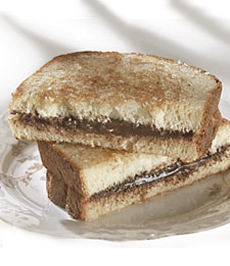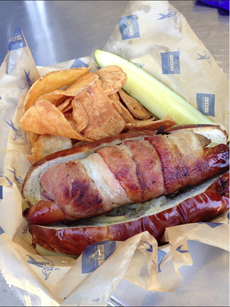|
Today, August 12th, is National Julienne Fries Day. We’re here to talk French fries, julienned, and beyond.
First, what are julienne fries? How do they fit in with all the other types of fries?
Julienne is a French cutting technique, typically for vegetables, in which the food item is cut into long thin strips, similar to matchsticks. Another word for the same cut is allumette.
The official julienne size is 1/8 inch × 1/8 inch × 2 inches.
The next thicker cut, batonnet, is 1/4 inch x 1/4 inch x 2½ to 3 inches.
The baton is the thickest stick cut: 1/2 inch x 1/2 inch x 2-1/2 inches.
Fries, or French fries, refer to sliced, deep-fried potatoes. They can be made with sweet potatoes instead of white potatoes, baked instead of fried, and served plain as well as with a myriad of condiments (barbecue sauce, blue cheese dressing, ketchup, gravy, malt vinegar, mayonnaise, mustard, ranch dressing, Thousand Island dressing.
While julienne and baton are the most typical cut, here is a delicious accounting of the different types of fries.
There are 30 different types of fries for you to try!
National French Fry Day is the second Friday in July (it was formerly July 13th).
A GLOSSARY OF THE TYPES OF FRIES
|
|
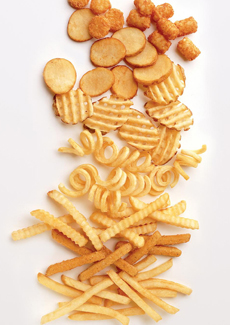
[1] Can you name the fries? From the top: tots, chips, waffle fries, curly fries, crinkle fries, sweet potato fries, and what most Americans think of as the classic French fry, the baton (photo © Idaho Potato Commission).
|
|
Bistro Fries: Served at bistros in metal holders, these “frites” are usually fried twice for extra crispness. They are thicker than julienne fries, typically 3/8- to 1/2-inch thick. They’re also called Euro fries.
Boardwalk Fries: From the Mid-Atlantic area, these long, square-cut fries are seasoned with Old Bay Seasoning and malt vinegar. Also called country fair fries.
Carne Asada Fries or Carne Fries: A specialty of Mexican restaurants in the San Diego area, comprising a base of fries topped with carne asada (grilled flank or skirt steak) with garnishes of cheese, guacamole, pico de gallo, shredded lettuce and sour cream; some establishments include pico de gallo and lettuce. Here’s a recipe.
Cheese Fries: Crinkle, julienne, or other fry shape topped with melted cheese: grated Parmesan, shredded Cheddar, mozzarella or Swiss cheese, Cheez Whiz, Velveeta—even blue cheese or ranch dressing. Chili, bacon, chives/green onion, garlic, jalapeños, mayonnaise, and other ingredients can be added. Here’s a recipe.
Chicken Fries: These are not potato fries, but chicken strips shaped to look like fries. They were popularized by Burger King and became a permanent menu item in 2015.
Chile Fries: Not to be confused with chili fries, this is a popular dish in New Mexico—fries topped with green chile peppers.
Chili Fries or Chili Cheese Fries: Fries topped with chile con carne.
Chip Butty: A U.K. sandwich of fries (called chips in the U.K.) on a buttered roll or bread, optionally eaten with condiments such as brown sauce, ketchup, mayonnaise, or malt vinegar.
Chips: The British word for fries. In America, the term can refer to homemade potato chips, a popular restaurant item. Make your own with this recipe, or try these gourmet homemade potato chips with truffle oil.
Chorrillana: A Chilean dish, a plate of fries is topped with strips of sliced beef, eggs, fried onions, and occasionally, sausages.
Cottage Fries: Thick coin shapes. Sometimes they are ridged.
Country Fair Fries: See Boardwalk Fries.
Crinkle or Crinkle-Cut Fries: Fries with grooved edges that are made with a special crinkle cutter.
Curly Fries: French fries cut with a special curly fry cutter that creates long, thin spirals. Sometimes called wavy fries, they are often served with melted cheese. Ketchup, sour cream, or sweet chili sauce are also popular condiments. History: In 1938 the Dolores Restaurant & Drive-In on Route 66 in Oklahoma introduced Suzi-Q Fries, adapted by others and called, generically, curly fries.
Curry Chips: Fries covered in curry sauce, a popular item served in chip shops in Ireland and Northern England (in the U.K., “chips” is the term for fries, and “crisps” is the term for what Americans call chips).
Disco Fries or Elvis Fries: A New Jersey specialty, made with steak fries topped with brown gravy and mozzarella cheese fries; some establishments substitute processed American cheese. Also, see Newfie Fries and Poutine.
French Fries, French Fried Potatoes or Fries: In French, the formal name for fried potatoes is pommes de terre frites (PUM-duh-tare-FREET). The term is often shortened to pommes frites or simply, frites. The terms aiguillettes or allumettes refer to very thinly sliced chips.
|
|
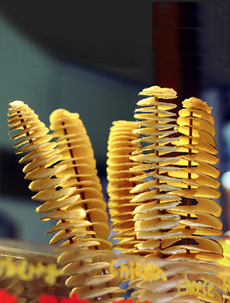
[2] Sidewinders, a new shape made to generate excitement at restaurants (photo © Simplot).
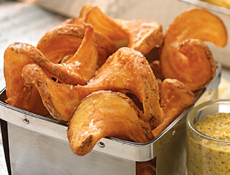
[3] Tornado fries, also called spiral fries (photo © DaphneLLC.Wordpress.com).

[4] Potato spirals, made by piping a mash into spirals. Here’s the recipe (photo © Taste Made).
|
|
Home Fries or Cottage Fries: A potato dish made by pan-frying sliced potatoes that have been par-cooked by boiling or other technique, then pan-fried in butter or oil—not deep fried. When diced green and red bell peppers are added, and optional chopped onions, they are called Potatoes O’Brien. The dish was created at John’s restaurant in Manhattan in the early 1900s. Here’s a recipe.
Julienne Fries: A popular width for French fried potatoes: 1/8 inch × 1/8 inch × 2 inches.
Jojo Fries: A regional term for potato wedges.
Loaded Fries: Top the fries with melted cheese, diced onions, sliced jalapeños, bacon, and sour cream. Here’s a recipe.
Matchstick Fries: Another name for shoestring fries.
Newfie Fries: A dish originating in Newfoundland: fries, dressing (turkey stuffing made with summer savory), and gravy. One variation adds ground beef or hot dogs and cheese.
Oven Fries: Also called baked fries, these are fries that are baked in the oven instead of fried. Here’s a recipe.
Patatje Oorlog: A Dutch dish of fries with eight or more sauces—anything from chopped raw onion and relishes to mayonnaise and peanut sauce. Some establishments provide up to 40 different condiment variations. Patatje oorlong is Dutch for “French fries war.”
Potato Wedges: Fries made from large, wedge-shaped chunks of potato, often unpeeled. Regional terms include jojos and tater babies. The wedges can be baked instead of fried. Popular condiments include barbecue sauce, brown sauce, gravy, ketchup, mayonnaise, ranch dressing, sour cream, and sweet chili sauce. Here’s a recipe for parmesan wedge fries.
Poutine: A Canadian dish from rural Quebec that tops French fries with fresh cheese curds (sometimes grated cheese), covered with hot gravy. Disco fries, from New England, are a variation. Here’s a classic poutine recipe.
Rounds: Coin-shaped chips.
Seasoned Fries: French fries coated with spices. Black pepper, garlic powder, chili flakes, onion powder, and paprika are popular, but you can make curry fries, basil-dill fries, or whatever you find appealing. Check out these recipes.
Shoestring Fries: Another term for julienne fries, the thinnest cut.
Sidewinders: A new shape developed by Simplot for restaurant service. The company describes the shape as a bent elbow. See the photo above.
Steak Fries: These are thicker-cut fries—baton or wider—often cooked with the skin on. They can be fried or coated with spices and baked. They are also called wedge fries. They are the least crunchy, as they have the highest interior-to-surface ratio (i.e., the most potato “filling.”)
Sweet Potato Fries: Made from sweet potatoes, typically in the julienne or shoestring cut, or in wider batons.
Texas Fries or Texas-Style Fries: Steak fries with the skin on.
Tornado Fries: A shape invented by the Tornado Fries company and copied by others. They are made from a single potato cut with a gadget into a one-piece spiral, which is fried on 18- or 26-inch skewers. Sometimes they are wrapped around a foot-long hot dog.
Tots or Tater Tots: Small cylinders made from deep-fried, grated potatoes. “Tater Tots” is a trademark of Ore-Ida, which invented the little potato bites in 1953. Here’s a recipe to make your own baked tots.
Waffle Fries or Waffle Cut Fries: French fries cut with a special tool into a criss-cross pattern. In France they’re called pommes gaufrettes (gaufrette is the French word for waffle).
Wavy Fries: Another term for curly fries.
Wedge Fries: Another term for steak fries.
|
THE HISTORY OF FRENCH FRIES/FRIED POTATOES
Potatoes originated in Peru and spread to other parts of Latin America. Fried potatoes—cooking potatoes in fat over a fire—is a practice thousands of years old.
Potatoes were “discovered” and brought back to Europe by the Spanish conquistadors in the 16th century—where they were used as hog feed! The French were convinced that potatoes caused leprosy, and the French Parliament banned the cultivation of potatoes in 1748.
Modern french fries date to the late-1600s. In the winter, when the rivers iced over and fishing was difficult, fried potatoes were substituted for fish at meals in some regions.
During World War I the fried potatoes were nicknamed “French fries” by the Americans because the official language of the Belgian Army was French. They carried the name back to America.
While the French had nothing to do with naming French fries (the term in French is pommes frites, fried potatoes), they did finally start eating potatoes in the 18th century.
A French army medical officer named Antoine-Augustine Parmentier was forced to eat potatoes as a P.O.W. and discovered their culinary potential. Through his efforts, in 1772, the Paris Faculty of Medicine finally proclaimed that potatoes were edible for humans—though it took a famine in 1785 for the French to start eating them in earnest.
In 1802, Thomas Jefferson’s White House chef, Honoré Julien, a Frenchman, served “potatoes served in the French manner” at a state dinner. The potatoes were “deep-fried while raw, in small cuttings.” French fries had arrived in the U.S., if not in name, then in form.
The French didn’t call them French fries, but frites, the word for fried potatoes.
So how did they get called “French” fries? One prevailing theory is that “French” came from American soldiers who arrived in Belgium during World War I. They came across frites.
Since the dominant language of southern Belgium is French, they dubbed the tasty potatoes “French” fries and brought the term (and the demand) back home.
Shortly afterward, in the early 20th century, the term “French fried,” meaning “deep-fried,” was being used for other foods as well (onion rings and zucchini sticks, anyone?)
UNESCO has declared the Belgian French Fry “a cultural treasure,” giving it Heritage Status. Belgian fries are served in a paper cone with mayonnaise and eaten with a small fork.
July 13th is National French Fry Day.
> MAKE YOUR OWN SIGNATURE FRENCH FRIES RECIPE.
> CHECK OUT THE DIFFERENT TYPES OF POTATOES & POTATO DISHES.
CHECK OUT WHAT’S HAPPENING ON OUR HOME PAGE, THENIBBLE.COM.
|
|








